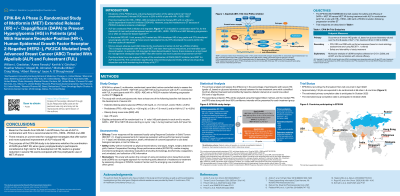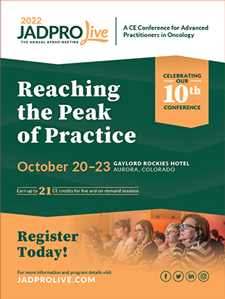Back

Industry Encore Posters
JL1011E: EPIK-B4: a phase 2, randomized study of metformin (MET) extended release (XR) +/− dapagliflozin (DAPA) to prevent hyperglycemia (HG) in patients (pts) with hormone receptor-positive (HR+), human epidermal growth factor receptor 2-negative (HER2–), PIK3CA-mutated (mut) advanced breast cancer (ABC) treated with alpelisib (ALP) and fulvestrant (FUL)
Saturday, October 22, 2022
10:00 AM – 11:00 AM ET


Stephen Nowmos, Pharm.D., BCPS (he/him/his)
Medical Liaison
Novartis
Newtown, Pennsylvania, United States
Poster Presenter(s)
Background:
ALP (α-selective PI3K inhibitor and degrader) is approved with FUL for pts with PIK3CA‑mut HR+, HER2− ABC. HG is a known on-target effect of PI3K inhibition, manageable with oral anti-HG agents such as MET and dose interruptions/modifications of ALP and reversible upon discontinuation of ALP. Although HG management guidelines were refined throughout the SOLAR-1 and BYLieve studies evaluating ALP + FUL/letrozole, there remains a need for optimized strategies beyond initial MET therapy that offers earlier and more sustained improvement of HG, particularly for pts at an increased risk for severe HG. In preclinical models, the addition of a SGLT2 inhibitor to ALP (+/− MET) reduced HG while maintaining ALP efficacy. The aim of this study is to evaluate the safety and efficacy of prophylactic MET XR +/− the SGLT2 inhibitor DAPA in reducing severe HG in pts with PIK3CA‑mut HR+, HER2− ABC on ALP + FUL with an increased risk for severe HG (grade ≥3) on ALP.
Methods:
EPIK-B4 is a Phase II, randomized (1:1), open-label, active-controlled study assessing the efficacy and safety of MET XR +/− DAPA (starting at Cycle 1 Day 1 [C1D1]) with ALP (300 mg orally [PO], once daily [QD], starting at C1D8) + FUL (500 mg intramuscularly on C1D1, C1D15, and D1 of subsequent cycles) in pts (N≈132) with HR+, HER2–, PIK3CA-mut ABC after progression on/after endocrine-based treatment (Tx). MET XR is administered PO starting at 500 mg QD (titrated up to 2 g QD) and MET XR + DAPA starting at 500 mg and 5 mg QD (titrated up to 2 g and 10 mg QD), respectively. Eligible pts include adult men or postmenopausal women with confirmed HR+, HER2–, PIK3CA-mut ABC and ≥1 risk factor for severe HG (diabetes [fasting plasma glucose (FPG) ≥126 mg/dL and/or HbA1c ≥6.5%], prediabetes [FPG ≥100 to < 126 mg/dL and/or HbA1c 5.7% to < 6.5%], obesity [BMI ≥30], age ≥75 years); prior endocrine-based Tx (eg, FUL or oral SERD) was permitted. Randomization is stratified by baseline diabetes status. Key exclusion criteria include >1 line of Tx in the metastatic setting; prior chemotherapy (metastatic setting) or PI3K, mTOR, or AKT inhibitor; type I or II diabetes requiring Tx; or antecedent of pancreatitis or severe cutaneous reaction. The primary endpoint is the occurrence of severe HG (grade ≥3 [glucose >250 mg/dL] based on laboratory assessments) over the first 8 weeks of ALP + FUL. Secondary endpoints include progression-free survival, overall response and clinical benefit rates with confirmed response, safety, and tolerability. A biomarker analysis is planned as an exploratory objective. Recruitment is ongoing with enrollment planned in 56 sites across 8 countries; completion of primary data collection is anticipated in 2023.
© 2022 American Society of Clinical Oncology, Inc. Reused with permission. This abstract was accepted and previously presented at the 2022 ASCO Annual Meeting. All rights reserved.
ALP (α-selective PI3K inhibitor and degrader) is approved with FUL for pts with PIK3CA‑mut HR+, HER2− ABC. HG is a known on-target effect of PI3K inhibition, manageable with oral anti-HG agents such as MET and dose interruptions/modifications of ALP and reversible upon discontinuation of ALP. Although HG management guidelines were refined throughout the SOLAR-1 and BYLieve studies evaluating ALP + FUL/letrozole, there remains a need for optimized strategies beyond initial MET therapy that offers earlier and more sustained improvement of HG, particularly for pts at an increased risk for severe HG. In preclinical models, the addition of a SGLT2 inhibitor to ALP (+/− MET) reduced HG while maintaining ALP efficacy. The aim of this study is to evaluate the safety and efficacy of prophylactic MET XR +/− the SGLT2 inhibitor DAPA in reducing severe HG in pts with PIK3CA‑mut HR+, HER2− ABC on ALP + FUL with an increased risk for severe HG (grade ≥3) on ALP.
Methods:
EPIK-B4 is a Phase II, randomized (1:1), open-label, active-controlled study assessing the efficacy and safety of MET XR +/− DAPA (starting at Cycle 1 Day 1 [C1D1]) with ALP (300 mg orally [PO], once daily [QD], starting at C1D8) + FUL (500 mg intramuscularly on C1D1, C1D15, and D1 of subsequent cycles) in pts (N≈132) with HR+, HER2–, PIK3CA-mut ABC after progression on/after endocrine-based treatment (Tx). MET XR is administered PO starting at 500 mg QD (titrated up to 2 g QD) and MET XR + DAPA starting at 500 mg and 5 mg QD (titrated up to 2 g and 10 mg QD), respectively. Eligible pts include adult men or postmenopausal women with confirmed HR+, HER2–, PIK3CA-mut ABC and ≥1 risk factor for severe HG (diabetes [fasting plasma glucose (FPG) ≥126 mg/dL and/or HbA1c ≥6.5%], prediabetes [FPG ≥100 to < 126 mg/dL and/or HbA1c 5.7% to < 6.5%], obesity [BMI ≥30], age ≥75 years); prior endocrine-based Tx (eg, FUL or oral SERD) was permitted. Randomization is stratified by baseline diabetes status. Key exclusion criteria include >1 line of Tx in the metastatic setting; prior chemotherapy (metastatic setting) or PI3K, mTOR, or AKT inhibitor; type I or II diabetes requiring Tx; or antecedent of pancreatitis or severe cutaneous reaction. The primary endpoint is the occurrence of severe HG (grade ≥3 [glucose >250 mg/dL] based on laboratory assessments) over the first 8 weeks of ALP + FUL. Secondary endpoints include progression-free survival, overall response and clinical benefit rates with confirmed response, safety, and tolerability. A biomarker analysis is planned as an exploratory objective. Recruitment is ongoing with enrollment planned in 56 sites across 8 countries; completion of primary data collection is anticipated in 2023.
© 2022 American Society of Clinical Oncology, Inc. Reused with permission. This abstract was accepted and previously presented at the 2022 ASCO Annual Meeting. All rights reserved.

